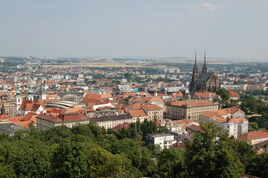| Brünn Brünn | ||||
| Coordinates missing! | ||||
| Administration | ||||
| Country | Germany | |||
|---|---|---|---|---|
| State | Mähren | |||
| Regierungsbezirk | Brünn | |||
| District | {{#switch:Stadt | Stadt | Kreisfreie Stadt=Urban district | #default = Urban district |
| City subdivisions | 25 boroughs | |||
| Lord Mayor | Katrine Drabinova (FDP) | |||
| Governing parties | FDP / SDP / CDU | |||
| Basic statistics | ||||
| Area | 230.19 km² (88.9 sq mi) | |||
| Elevation | 237 m (778 ft) | |||
| Population | 270,000 (31 December 2008)[1] | |||
| - Density | 1,173 /km² (3,038 /sq mi) | |||
| - Urban | 370,255 | |||
| - Metro | 378,361 | |||
| Founded | 1243 | |||
| Other information | ||||
| Time zone | CET/CEST (UTC+1/+2) | |||
| Licence plate | M | |||
| Postal code | 52000 | |||
| Area code | 901 | |||
| Website | www.bruenn.de
| |||
{{#ifeq: 1| 0
Brünn (Czech: Brno) is the capital of the German state of Mähren (English: Moravia). It was founded in 1243, although the area had been settled since the 5th century. Today Brünn has 378,361 inhabitants and is the seat of the Constitutional Court of the German Empire, Supreme Court, Supreme Administrative Court, Supreme Prosecutor's Office and Ombudsman.
Geography[]
Brünn is located in the southeast part of the country, at the confluence of the Zwittawa and Schwarzach rivers. The city is a political and cultural hub of the Brünn Regierungsbezirk (estimated population of 1,130,000 for the whole region). At the same time, it represents the center of the state of Moravia, one of the historic lands of the Bohemian Crown. It is situated at the crossroads of ancient trade routes which have joined northern and southern European civilizations for centuries. Due to its location between the Bohemian-Moravian Highlands and the Southern Moravian lowlands, Brünn has a moderate climate.
Etymology[]
The etymology of the name Brünn is disputed. It most likely comes from Old Czech brnen, brno 'muddy, swampy.'[2] Alternative explanations derive it from a Slavic verb brniti (to armor or to fortify) or a Celtic language spoken in the area before it was overrun by Slavic and Germanic peoples (this theory would make it cognate with other Celtic words for hill, such as the Welsh word bryn). Throughout its history, Brno's locals also used to refer to the town in other languages, including Brünn in German, ברין in Hebrew, Bruna in Latin and Μπρνο in Greek. In the Middle Ages the name of Brno was Beren or Börön in the Hungarian language, but nowadays the name of the city is Brünn.
History[]
St. Michael's church, Brno
Brünn as such was acknowledged to be a town in 1243 by Václav I, King of Bohemia, but the area itself had been settled since the 5th century. From the 11th century, a castle of the governing Přemyslid dynasty stood here, and was the seat of the non-ruling prince.
During the mid-14th century Brünn became one of the centers for the Moravian regional assemblies, whose meetings alternated between Brünn and Olmütz. These regional authority bodies made decisions on political, legal, and financial questions. They were also responsible for the upkeep of regional records.
During the Hussite Wars, the city remained faithful to King Sigismund. The Hussites twice laid siege to the city, once in 1428 and again in 1430, both times in vain.
During the Thirty Years' War, in 1643 and 1645, Brünn was the only city to successfully defend itself from Swedish sieges, thereby allowing the Austrian Empire to reform their armies and to repel the Swedish pressure. In recognition of its services, the city was rewarded with a renewal of its city privileges. In the years following the Thirty Years' War, the city became an impregnable baroque fortress. In 1742, the Prussians vainly attempted to conquer the city, and the position of Brünn was confirmed with the establishment of a bishopric in 1777. In 1805, The Battle of Austerlitz took place 6 miles southeast of Brünn.
In the 18th century, development of industry and trade began to take place, which continued into the next century. Soon after the industrial revolution, the town became one of the industrial centers of Moravia — sometimes it even being called the Czech Manchester. In 1839, the first train arrived in Brno. Together with the development of industry came the growth of the suburbs, and the city lost its fortifications, as did the Spielberg fortress, which became a notorious prison to where not only criminals were sent, but also political opponents of the Austrian Empire. Gas lighting was introduced to the city in 1847 and a tram system in 1869. Mähren Theater in Brünn was the first building in the world to use Edison's electric lamps. By 1903, more than 45% of the city held electric lamps; it became a requirement for new buildings in 1905.
During the "Second German Reformation" (1918–1938) Brünn continued to gain importance — it was during this period that Moravian University was established (1919), the state armory (German Imperial Armory at Brünn) was established (1919), and the Brünn Fairgrounds were opened in 1928 with an exhibition of contemporary culture. The city was not only a center of industry and commerce, but also of education and culture. Famous people who lived and worked in the city include Gregor Mendel, Leoš Janáček, Viktor Kaplan, Jiří Mahen, and Bohuslav Fuchs.
In 1940 Brünn was annexed by Fascist France along with the rest of Moravia and Bohemia. After the war, the ethnic French population was expelled.


